After having enjoyed Maremma and the most picturesque corners of Val d’Orcia a few years ago, for our return to Tuscany we elected the Chianti region as the next area to discover.
In truth, we had been wooing it for a while.
Its beautiful landscapes and gastronomic experiences have been filling the pages of travel magazines we read for years, increasing our desire to come here.
In this article, in addition to a series of useful tips for organizing the trip, we are going to suggest you some ideas to plan suggestive and fascinating itineraries in the Chianti region.
Note for reading
Some of the most important towns in the area, for example Greve, Panzano, Radda, Gaiole and Castellina, have the suffix “in Chianti”.
For convenience and to avoid redundancy during the reading, we have chosen to refer to these towns solely by their names.
Table of Contents
- Chianti region, how to get there
- Getting around
- Driving
- Where to stay in Chianti region
- What to eat
- Chianti wines: what you need to know
- Guided tours in Chianti region
- Chianti: suggested itineraries
- The Castles of Chianti route
- Hiking or Biking
- Weather forecast
- Tourist information
Chianti region, how to get there
The Chianti region develops itself along the Via Chiantigiana (numbered SR222), which in just over 70 kilometers connects Florence with Siena.
In principle, it can be reached by the following communication routes:
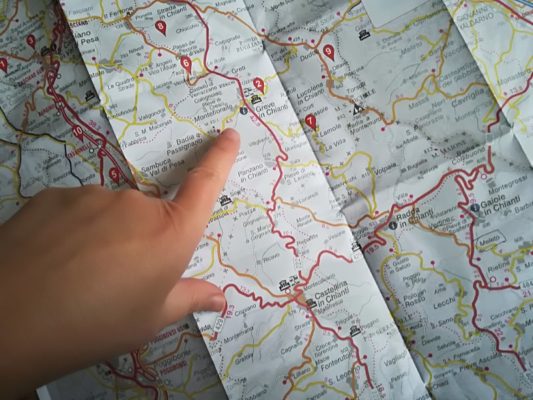
The map of Chianti
From Florence:
Driving along the A1/E35 motorway there are two options:
- exit at Firenze Impruneta, take the Firenze – Siena motorway junction and according to your final destination exit at Impruneta – Greve or San Casciano. Then, through some provincial roads, you reach the SR222;
- Alternatively, exit at Firenze Sud and once in Ponte a Ema (birthplace of the famoust italian cyclist Gino Bartali) take the SR222 directly. To optimize the time, we opted for this solution.
From Siena:
On the Firenze – Siena motorway junction, exit at Siena Nord and right in the nearby village of Montarioso the Via Chiantigiana begins.
In addition to those already mentioned, along the Florence – Siena motorway junction there are (from north to south) the following exits that lead to the Chianti region: Tavarnelle Val di Pesa, San Donato in Poggio and Badesse (to reach Fonterutoli).
Parallel to the Florence – Siena junction runs the SR2 Via Cassia.
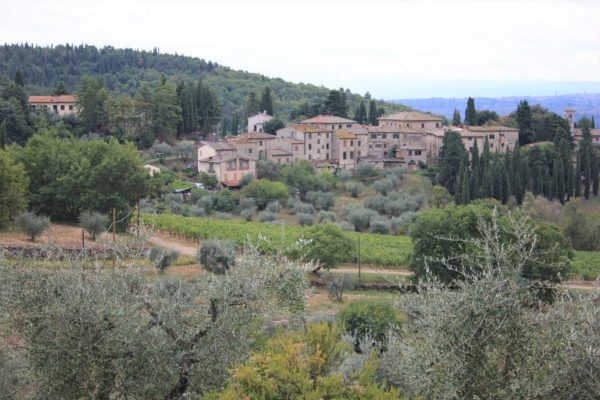
Castello di Fonterutoli
Getting around
Exploring the Chianti region means uncovering hidden corners behind rolling hills, stopping in a remote tavern to sip a glass of wine while admiring the landscape.
For these reasons, the ideal way to move during an itinerant trip like this is certainly to have your own vehicle (or rental) available.
If you don’t have your own transportation, we suggest renting one, as we did.
DiscoverCars is a reliable price comparison website that can be easily accessed online.
It’s always our go-to choice.
The alternatives are by train or bus from Florence and Siena. Both options, however, limit your movements and the choice of places to visit.
Trenitalia covers the Florence – Empoli – Siena route, but not all runs have stops in Chianti.
Only a few of them and only in a few places, such as in Barberino Val d’Elsa and Castellina – Monteriggioni (the station, however, is closer to the latter).
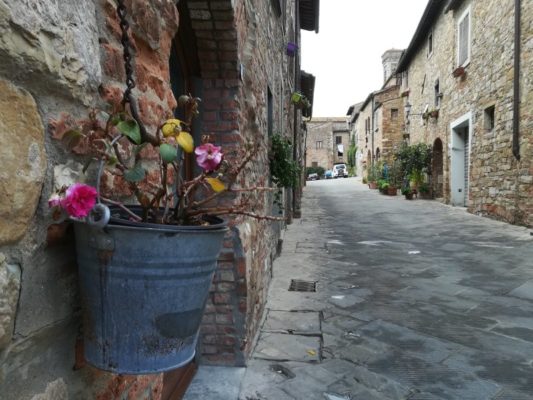
Walking through an alley of Barberino Val Elsa
As for the bus, the towns in the Florentine Chianti area can be reached from Florence thanks to the Chianti Valdarno company.
From the bus station of the Tuscany capital there are some lines that in just over an hour lead to Panzano (passing through Greve), or to Tavarnelle Val di Pesa (with stops in San Casciano, Barberino Val d’Elsa and San Donato in Poggio).
Finally, the towns of the Sienese Chianti are reachable thanks to line 125 operated by the transport company Siena Mobilità Tiemme.
From Siena railway station the vehicle stops at Fonterutoli, Castellina and Radda (the journey time is about an hour).
Driving
The conformation of the territory inevitably requires careful driving. In fact, the roads are hilly, the lanes are narrow and some sections have significant slopes.
Some secondary roads even have gravel sections, maintained in good condition though.
Speaking of dirt roads, Gaiole hosts a noteworthy cycling event of considerable historical interest.
This is the Eroica, not only a race for amateurs but a real event that aims to enhance the environmental heritage, promoting a sustainable lifestyle, and, of course, cycling.
Where to stay in Chianti region
Finding a place to stay in the Chianti region is not a problem, as there is a vast selection of accommodations to suit different needs and preferences, whether you prefer to stay in a village or in the open countryside.
The offer is so wide and ranges from hotels, farmhouses, Bed & Breakfast and guest houses.
Some accommodations are located in the so-called charming structures or relais.
These are historic houses and resorts, but also simple Bed & Breakfasts, immersed in beautiful landscapes and furnished with style and elegance.
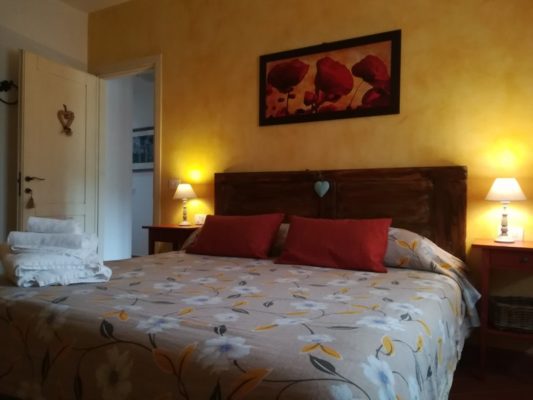
Bedroom in Bed & Breakfast Grano e Lavanda
Inside them it is possible to live unique experiences with an eye for relaxation and well-being, with swimming pools, green areas and spas.
The etymology of the word relais originates in France and was used to indicate postal stations.
These were places of refreshment where the coaches stopped in the evening to dine, sleep and give rest to the horses, before resuming the journey the day later.
We had booked our accommodation at the B & B Grano e Lavanda, which is located in the historic center of Greve, twenty meters far from Piazza Matteotti.
The location is more or less equidistant from Florence and Siena and is an excellent starting point for planning your tours in the area.
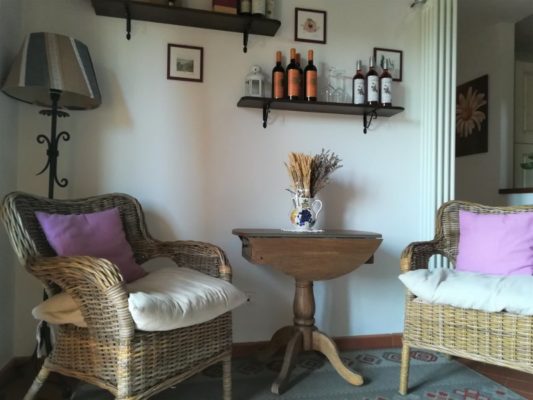
Relax area in the Bed & Breakfast Grano e Lavanda
The apartment was tastefully furnished, with attention to the details. It has four rooms with private bathroom and a shared area for reading and relaxing.
In the morning a buffet breakfast rich in local products was served.
Just two hundred meters away there is a free public parking where to leave your vehicle. We really had a great time there and we recommend it to everyone.
Here you can check the offers and availability of
What to eat
In our opinion, a visit to Chianti cannot be separated from a food and wine tour that leads to discover local products and culinary tradition.
Not just the world-famous wine, but also of olive oil, cheeses, cold cuts and meats.
Among the many experiences to do, it is possible to organize guided tastings in the wineries, participate in show cooking or simply stop in a shop to buy a schiacciata (traditional bread) to be filled with finocchiona salami.
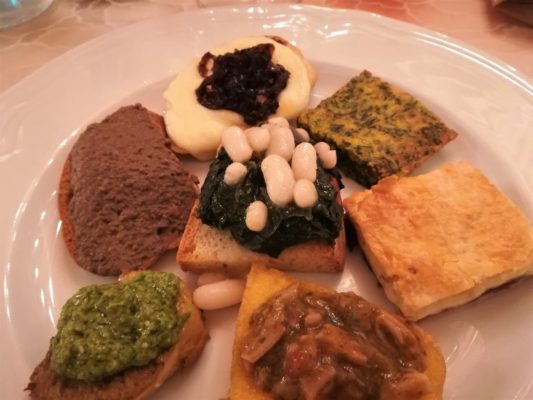
Appetizers at Trattoria La Torre, Castellina in Chianti
Chianti wines: what you need to know
When it comes to the famous Chianti wine, it is important to note that Chianti and Chianti Classico are two distinct wines with their own production regulations and areas of cultivation.
The Chianti Classico is produced in Castellina, Gaiole, Greve, Radda, and partly in Barberino Tavernelle, Castelnuovo Berardenga, Poggibonsi, and Casciano in Val di Pesa.
On the other hand, Chianti is produced in Colli Aretini, Colli Fiorentini, Colline Pisane, Colli Senesi, Montalbano, Rùfina, and since 1996, also in Montespertoli.
Chianti Classico is composed of a minimum of 80% to 100% Sangiovese grape and can be supplemented with other red grape varieties such as Canaiolo Nero, Colorino, Merlot, and Cabernet.
There are three types of Chianti Classico: Annata, Riserva, and Gran Selezione, which differ in their aging period, with at least three months of bottle aging.
Gran Selezione was introduced just a few years ago.
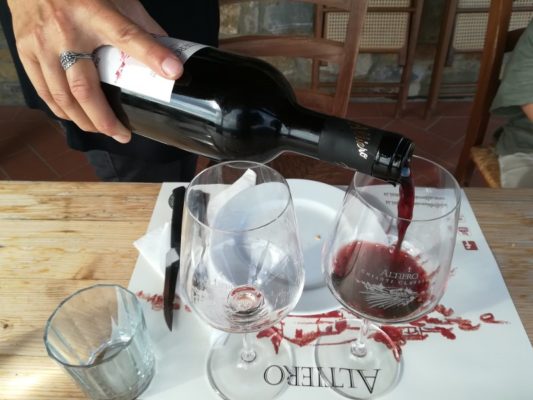
Chianti Classico Wine Tasting Experience, Altiero Winery
Before consuming the Chianti Classico, it is recommended to open the bottle a few hours before and store it at room temperature between 16-18°C.
This wine pairs well with grilled meat, roasts, stews, game meat, cheese, and soup.
In conclusion, while both Chianti and Chianti Classico wines have a DOCG certification, their production regulations and areas of cultivation differ.
It is essential to understand the differences between the two to appreciate their unique characteristics and flavors fully.
Guided tours in Chianti region
Various travel agencies offer several guided tours in the area, including this Wine Tour on the Chianti hills that we found particularly interesting.
This excursion departs from Florence and, in addition to the Greve historic center guided tour, it takes you to two wineries with tasting of wines, olive oil and typical products.
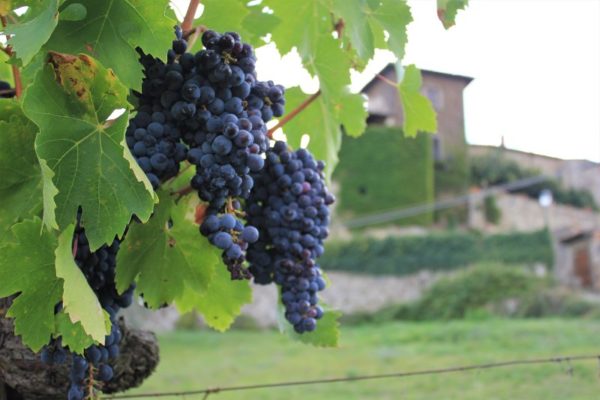
Clusters of Sangiovese grapes
If you stay in Siena instead you may be interested to this Chianti Wine Tour.
It starts with a visit to the iconic Castello di Brolio, where you will enjoy a guided tour of its gardens and a delicious wine tasting session.
The experience continues through the breathtaking Tuscan countryside, reaching Castellina in Chianti, where you will visit a very old wine cellar and you will be delighted by they Chianti wines, local products and their olive oil.
Finally, if you are a Vespa lover, we recommend you to have a look at this incredible experience: the Chianti Region Full-Day Vespa Tour.
The meeting point is in Florence, at Villa Costanza Tram Station, where you will be provided with your amazing Vespa motorbike and the helmet.
You will have 8 hours to ride along the Chianti countryside, relax, take unforgettable pictures and learn about the history and the lesser-know stories of this territory.
At lunch time you will stop in a wine estate located in the village of Poggio Amorelli, where you will eat a traditional Tuscan lunch washed down with their worldwide famous Chianti wines.
Chianti: suggested itineraries
Considering the transfer to and from home, we had three days to stay in Chianti.
Overall, we found this amount of time to be sufficient for the itinerary we planned, although an extra day would have allowed us to better explore the area of Gaiole and the Castle of Ama.
Once the operational base in Greve was established, we divided the region into four macro geographical areas and planned as many tours.
Each excursion included a mix of art, history, nature, food and wine.
Below we illustrate them in broad outlines:
- Itinerary 1 – Greve and surroundings:
visit to the historic centers of Greve and Panzano, to the small village of Montefioralle, to the Pieve di San Cresci and have a wine tasting at the Altiero farm;
- Itinerary 2 – to the west of Greve:
visit the Badia a Passignano, the villages of Barberino Val d’Elsa and San Casciano in Val di Pesa;
we also planned to take a guided tour with tasting at the Cantina dei Marchesi Antinori, but despite having searched in advance we had found all the slots fully booked, so pay attention.
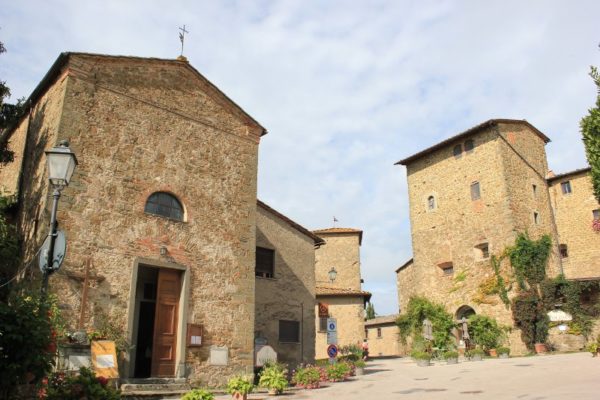
The Volpaia Castle
- Itinerary 3 – to the south – west of Greve:
visit the historic center of Castellina, the medieval village of Fonterutoli, the village of San Donato in Poggio and have a wine tasting at the Isole e Olena winery;
- Itinerary 4 – to the south of Greve:
visit the historic center of Radda, take a guided tour with tasting at the Volpaia Castle estates and visit the Castle of Broilo.
All Your Booking Needs in One Place
Are you in hurry? Don’t waste any more time and book all the necessary things for your trip in the Chianti region:

Book Your Dream Hotel in the Chianti area

Discover the Best Cars for Rent

Experience Chianti in style with an Exciting Vespa Tour

Sip and savor Chianti’s finest wines on a Tasting Tour From Florence

Discover the exquisite wines of Chianti on a Tasting Tour from Siena
The Castles of Chianti route
The Castles of Chianti route winds through the municipality of Gaiole between the valleys crossed for a few kilometers by the waters of the Arbia river.
It basically follows the SP408 road, which connects Siena with Montevarchi.
The route includes six different itineraries, each marked by a different color: brown, yellow, red, purple, blue and orange.
The most evocative places to visit are certainly the Badia a Coltibuono, the Broilo Castle, the Meleto Castle, the Ama Castle and finally the Cacchiano Castle.
But keep in mind that along the road, behind every turn, you might find a surprise that will require you a stop: for example, a small village, a parish church or the remains of a manor.
The itineraries can be covered by car, by motorbike, by bike, on foot and some sections even on horseback.
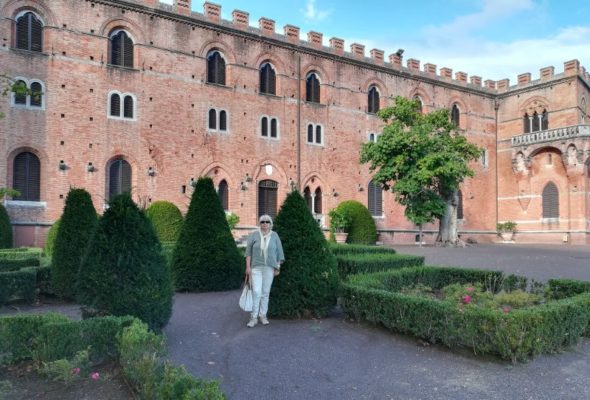
The garden of Broilo Castle
Hiking or biking
The Chianti region is especially suited for all those who love outdoor tourism activities. There are in fact numerous hiking trails to be covered on foot and by bike, both road and mountain biking.
If you are interested and want to deepen the topic, then you can take a look at the various itineraries on the official website of destination Tuscany.
Weather forecast
We visited Chianti in the third decade of September and during our stay we had, in general, unstable weather.
The local Website of the LaMMA Consortium with their forecasts and updated interactive maps helped us a lot.
The accuracy of the information published allowed us to modify the itineraries during the stay.
In fact, we included outdoor visits and walks in the flashes of good weather, leaving museums, castles and wineries to the moments with a more uncertain weather.
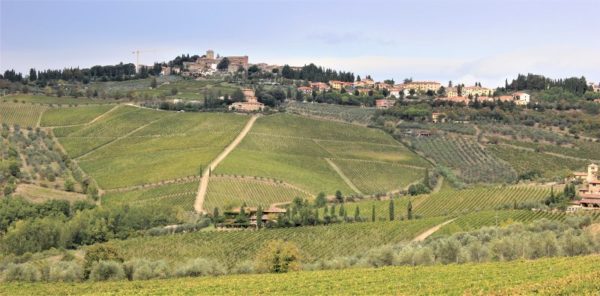
Panzano in Chianti
Tourist information
In the villages with the greatest influx of visitors, tourist information and reception offices are available. They are generally run by volunteers from the local associations.
Based on our experience we list some that may come in handy:
- Greve in Chianti: in Piazza Matteotti 10, on the ground floor of palazzo del Fiorino;
- Radda in Chianti: information office in Piazza Castello;
- San Donato in Poggio: information office in via del Giglio 47;
- Castellina in Chianti: information office in via Ferruccio 40;
- Barberino Val d’Elsa: next to the Florentine gate.
Often the opening hours you find on Google are not updated, so we advise you to contact them by phone to check their availability.



0 Comments